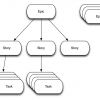 |
Code Factories: Making Agile Work in Large Organizational Teams Making the transition to agile can be difficult for teams that are used to working in large groups and reporting to a single manager. Kris Hatcher suggests a new way to work: in smaller teams called code factories, which are created to stick with a specific product throughout its lifetime.
|
|
 |
Do Cross-Functional Teams Mean Cross-Functional People? Managers who want high-performing agile teams may think this involves finding people who all possess every required skill. But in addition to that being unlikely, it would also be a bad idea; it's the mix of perspectives that really gives benefit and value to the business. Instead, find experts in individual skills who can collaborate well together.
|
|
 |
Estimating Business Value in the Shark Tank You can use analytical methods to assign business value to a user story, of course, but another way is simple estimation. Allan Kelly describes an estimation exercise that combines the Scrum tool of planning poker with a TV show format to add some fun. You end up with enlightening conversation and revealed requirements.
|
|
 |
Who Is the Real Product Owner? Communication is always vital on an agile project to ensure everyone is on the same page, but it's perhaps most important in a relationship between a vendor and a customer. Here, Marcus Blankenship relates a personal story about a project where communication failed, and gives some good tips for how to avoid it happening to you.
|
|
 |
Use Lean Thinking to Accelerate DevOps Performance for Agile Teams Leaders in agile organizations should consider adding lean techniques to their DevOps practices. Lean thinking can accelerate DevOps delivery by providing a set of processes and principles to help create more beneficial products, save money, boost productivity, reduce waste, and map to value.
|
|
 |
5 Ways Testers Can Mitigate Practical Risks in an Agile Team Testers who analyze quality in every aspect of the team’s deliverables also have a responsibility to mitigate risks and practical issues that are bound to come up, and help the team succeed in their product as well as at being agile. Here are five such issues that testers can help the team alleviate or avoid.
|
|
 |
Product Owner, Product Manager, or Project Owner? If you really want to get the benefit of Scrum, you have to make the mind shift to product ownership, not project management or project ownership. The product owner role is often thought of as being a requirements specifier, when in fact a good product owner is a value maximizer, and a great product owner is a product maximizer.
|
|
 |
The Scrum Daily Standup Meeting: Your Questions Answered The daily standup, or daily scrum, is a short meeting the team uses to briefly communicate work commitments with each other. Dick Carlson answers some questions that agile teams, management, stakeholders, and those who are thinking about transitioning to agile commonly have about these daily standup meetings.
|
|
 |
Stories, Epics, and Tasks: Organizing Agile Requirements Some teams only work with stories, but it can be difficult for a team new to agile to write stories that are easy to understand and provide value every time. An alternative is to add epics and tasks. Understanding the differences between each level and knowing what size story to use for each situation will improve the accuracy of your sprint planning.
|
|
 |
How Business Teams Can Embrace Agile Techniques As agile principles and practices receive greater organizational exposure, business teams are embracing certain aspects of agility that were traditionally reserved for technology teams. This article details the experiences of a group of people with business roles who have adopted some agile methods and how their teams have benefitted.
|
|
